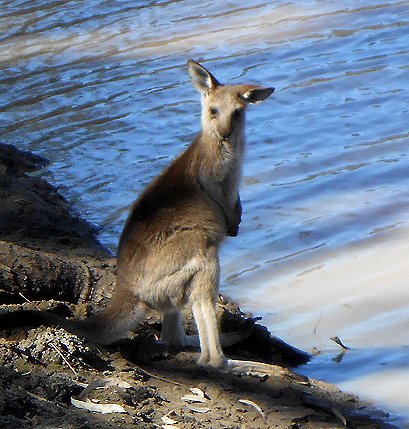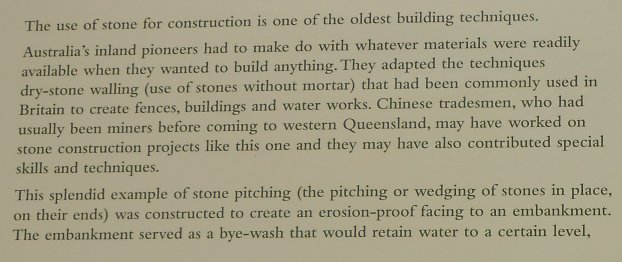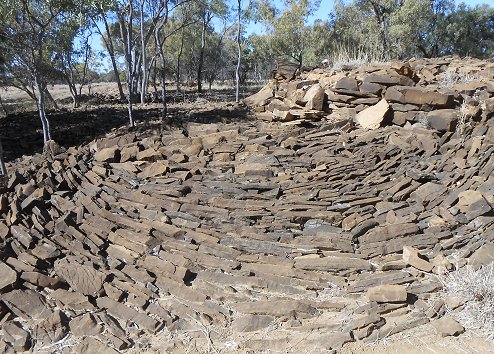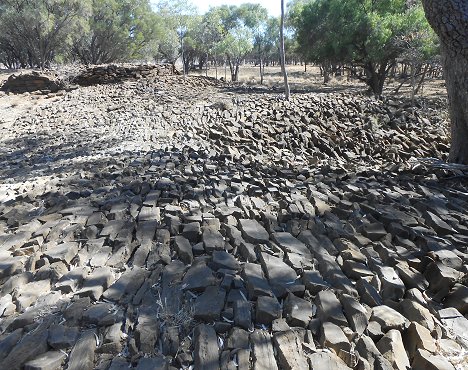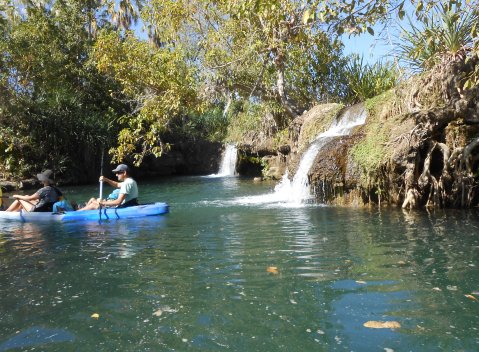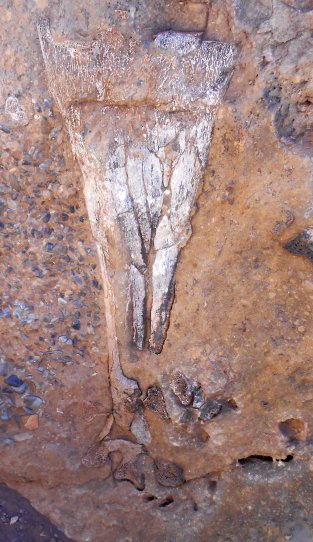15th July, 2013
We’ve spent nearly seven weeks on the Atherton
Tablelands and have only ventured to the coast a couple of times. Before we continue our travels we decide to
take a day trip down to Cairns and follow the coastal road to Port Douglas. The city of Cairns has grown over the years
and fields of sugar cane have now been replaced by ever expanding
suburbia. The foreshore has had a
facelift and mangrove lined mudflats are now relegated to north and south of
the main tourist area. Many of the
tourist coastal towns are starting to look alike – with promenades along the
waterfront parklands, one way boulevards and street cafes. The coastal drive to Port Douglas is still
very picturesque with the aqua blue waters lapping against palm fringed
beaches. We make our way to the lookout
and are absolutely stunned to discover that the once beautiful view along the
coast is being marred by the construction of a building/residence.
 |
| Lookout at Port Douglas - View spoiled by ugly construction |
We wonder what idiot or idiots in the local council
allowed this structure to be built. For
a locality that promotes itself as a tourist venue the loss of this wonderful
outlook is unforgiveable. Ahh well! Sometimes money speaks louder than
words. At Mossman we are transported back
to another time – when life ran at a slower pace and the cane trains ran even
slower.
 |
| Sugar Cane Train at Mossman |
A pleasant drive up the mountains brought us up onto
the tablelands and back to our base camp at Walkamin Caravan Park. A few days later we packed up the rig, waved
goodbye to the many friends we had made at the caravan park and hit the
road. We travelled south to Ravenshoe
and called in at Millstream Falls
 |
| Millstream Falls |
where we met a friendly kookaburra in the parking lot.
 |
| Kookaburra at Millstream Falls |
We free camped that night at Archer Creek and the next
day checked into Bedrock Village Caravan Park at Mount Surprise. We took a walk across the railway tracks and
passed the old cemetery.
 |
| Mount Surprise Cemetery |
Mount Surprise is a railway town on the old Cairns to
Forsayth Railway Line. It is the centre
for gem fossicking with topaz, quartz, garnet and aquamarine to be found. We stop in at the gem shop and take out a
fossicker’s licence. We plan on heading
out to the gem fields for a picnic lunch tomorrow and try our luck. The following morning we head out to Kalkani
Crater which is part of the Undara Volcanic National Park. Situated on the McBride Volcanic Province,
the Undara Volcanic National Park is 40 km east of Mount Surprise with evidence
of volcanic activity from 164 craters.
One of the most recent and major eruptions 190,000 years ago produced 23
cubic kilometers of lava, most of which flowed down the western side of the
Great Divide. This flow created a
geological phenomenon now known as the Undara Lava Tubes. The lava tubes wind for over 90 km
underground, making them the longest network in the world. Undara is an aboriginal word for ‘a long
way’. We walk up the side of the Kalkani
Crater and around the rim.
 |
| View from Kalkani Crater |
From the rim we can see the surrounding countryside
and the occasional line of green trees and shrubs that mark the location of
collapsed lava tubes. We visited the
lava tubes many years ago and they are certainly worth a look see if you
haven’t been before. At that time we had
no idea this volcanic crater was here and it is great to get a different
perspective on the enormous size of this national park. We make our way back to Mitzi and drive to
O’Brien’s Creek gem fields for a picnic lunch beside a very dry and dusty,
rocky water course. We pick a likely
looking spot to find gems (how the hell do we know) and for the next few hours
proceed to move an abundant amount of rocks and dirt from one place to another.
We have a sieve to plonk the shovels
full of potential gem bearing earth into but all we find is smoky quartz.
 |
| Don't think that Wok is really taking this fossicking game seriously |
We may be pretty hopeless at gem fossicking but it was
fun trying and certainly gave us a good workout. The whole afternoon wasn’t a dead loss though
– we were just about to give up when Wok dug up a ‘burrowing frog’.
 |
| A burrowing frog - isn't he cute? |
This poor little guy/girl was minding his/her own
business and hibernating way down in the earth when along we come, dump him/her
in the sieve and shake the living daylights out of it. Wok rescued the frog from the sieve and after
taking its photo dug a nice hole (well we thought it looked nice – the frog
seemed to have no opinion either way) then placed the frog in the hole and
covered him/her back up. These
‘burrowing frogs’ are amazing – they hibernate for months and months waiting
for the wet season to arrive. When the
rains come and the creeks flow they emerge and breed. When the wet season is over they burrow back
into the earth and the cycle starts all over again. Nature is truly incredible! After our trek up and around the volcanic
crater in the morning and an afternoon of dusty digging we sure did appreciate
the luxury of a good shower back at the campground. At midday the following day we joined a group
of fellow travelers for a ride on the Savannahlander. This historic rail motor was established in
the 1900’s and now operates once a week between Cairns and Forsayth as a
tourist attraction. We are only going to
join it for one leg of its journey – between Mount Surprise and Einasleigh.
 |
| The Savannahlander |
The train gets along at a dignified pace and the
driver regales us with the history of the train and the countryside we are
travelling through. As this is a tourist
train the driver has no qualms about slowing down or stopping so that the
passengers can get that perfect photo. A
stop along this creek crossing caused a bit of a problem when the train didn’t
have enough oomph to pull up the slight slope on the other side.
 |
| Crossing a creek in the Savannahlander |
It wasn’t a problem though! The driver just backed the train up for a
short distance and this time had enough speed up to make it to the top of the
rise. We did have a few kangaroos that
seemed to have no idea where to go when the train came along and at one stage
we thought that this herd of cattle was going to follow the train line all the
way to Forsayth.
 |
| Following the Leader - 'moo cow style' |
After ambling along single file for about a kilometre
they finally decided to leave the track and head for the bush. There is no train station in Einasleigh but
the driver takes care of that by stopping the train in the middle of the
road. Everyone then hops out and
adjourns to the pub for some liquid refreshments.
 |
| Einasleigh Station .... ? errr Railway Crossing ... ? Oh let's all just go to the pub! |
After a suitable stopover time the train continues on
its merry way to Forsayth while our group enjoys another round of drinks at the
Einasleigh Hotel.
 |
| Einasleigh Hotel |
A short distance from Einasleigh is Copperfield Gorge.
 |
| Copperfield Gorge at Einasleigh |
It is hard to imagine what it must be like in the wet
season up here. This whole gorge is
covered in raging floodwater. Large
depressions have formed where boulders have been rolling around gouging into
the rock making mini waterholes.
 |
| Round depressions at Copperfield Gorge |
Now we suppose you are wondering how we are going to
get back to Mount Surprise now that the train has deserted us. Well we have that covered – a mini bus is
picking us up from Einasleigh and taking us back to the caravan park. Along the way we stop for an afternoon
tea. The driver boils the billy over an
open campfire and he has some home-made biscuits and slice …. Yummm!
 |
| Boiling the Billy |
We also stop at Jardine Waterhole which is named
after the Jardine Brothers who stopped to water their cattle on the long drove
north to their father’s property at Somerset (the top of Cape York
Peninsula). Here our driver shows us
some ‘Nardoo’ - a plant that grows in
waterholes and billabongs and is/was used as a food source by the aborigines.
 |
| Our driver showing us the Nardoo Plant |
The ‘Nardoo’ needs to be ground into a paste before it is eaten otherwise it
can be poisonous. It is this plant that is
thought to have contributed to the deaths of the Burke and Wills exploration
party because they did not prepare it properly as shown to them by the
aboriginals. We return back to the
campground in time for some wood fired pizzas for dinner. A great ending to a novel day!
We’re packed up and on our way again – heading west
through the Gulf Savannah country. We
stop at Croydon to refuel and have a wander around the old town. With the discovery of gold in 1885 Croydon
became a rich, booming, gold mining centre.
The town still calmly sits on top of deep untapped gold reserves and the
historic Gulflander Train travels to Croydon from Normanton once a week. There are many old buildings here that were
built between 1887 and 1897 and one can wander through them. We stop for a look at the Court House
 |
| Croydon Court House |
and the Town Hall with its unique clock tower.
 |
| Croydon Town Hall |
After a good look around town we continued west and
free camped for the night with a herd of
cattle beside a waterhole. The next day
we continued on and thirty kilometres east of Normanton pulled into Leichardt Lagoon
Camping Park. This sign in the
campground certainly pulls no punches
but Wok hasn’t seen the sign yet and thinks he has
found the ideal spot.
 |
| Camping spot at Leichardt Lagoon |
That night we headed up to the station homestead for a
three course dinner (vegetable soup, corned meat and vegetables, rhubarb pie
and icecream) and some live entertainment.
Part of the live entertainment turned out to be Ken our next door
neighbour at the campground who can play the didgeridoo.
 |
| Ken plays the didgeridoo at the homestead cookout |
It was a good night and all
for the princely sum of $5 each – really good value for money. The next day we relaxed and went fishing in
the Norman River not far from the campground.
We caught no fish but that may have been the fault of the large
saltwater crocodile that was patrolling up and down on the far side of the
river. That night as the sun set, Ken
sat beside the lagoon and played some more ‘didg’ music. If ever there was an ideal place to hear the
didgeridoo then we think that this fit the bill perfectly. It was a magical evening!
In the morning we broke camp
and headed into Normanton. Originally
established on the Norman River by William Landsborough as the port for the
Croydon gold rush, Normanton is now the major service centre in the Gulf
Savannah. It’s not a large town but does
boast three pubs – one of which is painted an eye catching purple. And what would you call a pub that is painted
purple? Why the Purple Pub of
course! We Australians are an
imaginative lot when it comes to naming things!
 |
| The Purple Pub at Normanton |
The old general merchants’
building has been restored and now houses the Information Centre, library and
museum.
 |
| Burns, Philp & Co Ltd. - General Merchants from late 1800's |
Whenever people have talked
to us about Normanton – the one thing they all mention is the statue of the
huge crocodile in the main street. Yes –
there are saltwater crocodiles in the river but that is no different to many
towns and rivers in the top end. So when
we did spot the huge croc statue in the park beside the council chambers we just
had to stop and have a look. The sign
beside the croc explains the reason for it being here.
Oh my God! Just standing near the replica sends shivers
up our spine!
 |
| The replica of Krys the Croc holds no fear for this youngster |
Although crocs of this size
haven’t been seen in decades there still could be some monsters lurking in
remote areas. We will be quite happy for
them to stay right where they are!
We travel 80 kilometres
north to the mouth of the Norman River.
Here lies Karumba, the centre of the Gulf’s prawning and barramundi
industries. The wetlands here extend for
30 kilometres inland and are the home of saltwater crocodiles, pelicans,
brolgas, black swans and many bird species.
We have seen pairs of brolgas before as we have travelled but as we near
Karumba there are vast flocks of brolgas in the grasslands beside the
road. We take a drive around Karumba to
check out the facilities and then head five kilometres north to Karumba Point
and book into Sunset Point Caravan Park for a few days. Karumba and Karumba Point are popular
destinations for fisher people and many travellers come for the winter. This is one of those places that it is wise
to book ahead as there are no free camps here.
We managed to get a site for three days between two long term bookings
by phoning over a week ago. We figure that
will give us enough time to check out the place to see if it may be somewhere
we might like to come back to and spend more time at. Opposite the caravan park is the boat ramp
and the car park is full with cars and boat trailers. At the boat ramp it is standing room only as
fishermen return with their boats and wait while their fishing buddies jostle
for a place on the boat ramp with their cars and trailers.
 |
| Standing Room only on the Karumba Point boat ramp |
North along the beach more
people are spread out trying their luck at fishing from the shore.
 |
| Fishermen at Karumba Point |
We chat to some of the
regular winter fishermen in the caravan park and they are all disappointed by
the number of fish they are catching.
Although they are catching some species of fish, the barramundi are
elusive. One doesn’t have to be a genius
to work out why the fish catches are down.
Trawler after trawler chug in and out the river mouth and a multitude of
small boats head off each day. Could it
perhaps be a simple case of too many fishermen and not enough fish ....? Over the next couple of days we tried our
hand at beach fishing but didn’t even get a bite. However, we did get stalked by a stork that
was keen to see if we had caught anything each time we pulled our lines in
 |
| I'm just waiting here to see what you might catch .... |
and we were entertained by
an adult brolga trying to show a juvenile brolga the fine art of fishing. At least the brolga was catching something
even if it was minuscule.
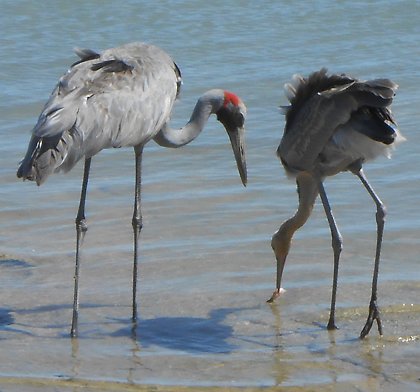 |
| Hey Mum - Are you sure we really like to eat these things? |
Ahh Karumba! It could be a lovely place if it weren’t for
all those fishermen....










